Vonovia Bundle
Can Vonovia Rebound and Thrive?
Vonovia, a titan in European real estate, boasts a century-long legacy, evolving from its roots in providing housing to becoming a DAX 40 heavyweight. With a massive portfolio valued at billions, the company's journey reflects an impressive story of growth and market dominance. But what does the future hold for this real estate giant?
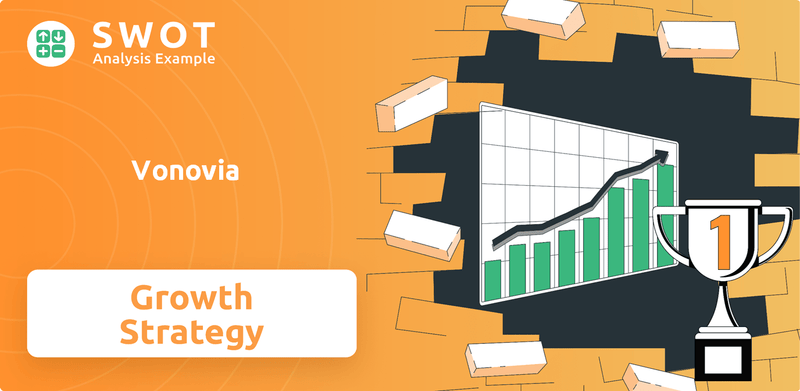
As Vonovia navigates the complexities of the German housing market and beyond, understanding its Vonovia SWOT Analysis is crucial for investors and strategists alike. This company analysis delves into Vonovia's growth strategy, exploring its expansion plans, financial performance review, and sustainability initiatives. Furthermore, we'll examine the impact of interest rates, dividend policy, and market share to provide a comprehensive view of Vonovia's future prospects in the competitive real estate investment landscape.
How Is Vonovia Expanding Its Reach?
The future prospects of the company are significantly shaped by its expansion initiatives, which are central to its 'Return to Performance' strategy. This strategy focuses on strengthening value-add services, development projects, and recurring sales to drive growth. The company is committed to substantial investment increases, aiming to double its annual investments to up to €2 billion by 2028, compared to the 2024 level, focusing on climate initiatives, technology, and new construction.
A key element of the expansion strategy is the resumption of new construction. The company completed 3,747 new residential units in 2024. Looking ahead to 2025, the company plans to commence construction on around 3,000 new units. The long-term goal is to develop approximately 70,000 new apartments on its properties, contingent on favorable political frameworks that reduce construction costs.
Geographic expansion has also been a focus. The company has expanded its presence in Europe through acquisitions, such as conwert in Austria in 2017 and BUWOG in Austria in 2018, as well as Victoria Park (2018) and Hembla (2019) in Sweden. These moves aim to access new customer bases and diversify revenue streams. The company is also exploring opportunities to grow its activities in the third-party market.
The company plans to enhance its value-add services to improve customer satisfaction and generate additional revenue streams. This involves expanding maintenance services and offering more comprehensive property management solutions. These initiatives are designed to increase the value of its properties and improve tenant retention rates.
The company is actively resuming new construction projects, with a focus on building sustainable and modern residential units. The goal is to increase the housing supply and meet the growing demand in key markets. The company is also focusing on modular new builds and serial modernization to improve efficiency and reduce costs.
The company is capitalizing on market effects through recurring sales to generate consistent revenue. This involves selling properties to generate cash flow and reinvesting in its core business. This strategy helps to optimize the company's portfolio and improve its financial flexibility.
The company has expanded its European footprint through acquisitions in Austria and Sweden. These expansions aim to diversify revenue streams and access new customer bases. The company is also exploring opportunities to grow its activities in the third-party market.
The company's expansion strategy involves significant investments in various areas to drive growth and improve financial performance. These strategies include new construction, geographic expansion, and value-add services. These initiatives are designed to strengthen its market position and create long-term value for shareholders.
- Increase in annual investments to up to €2 billion by 2028.
- Construction of approximately 3,000 new units in 2025.
- Focus on modular new builds and serial modernization.
- Further expansion in the third-party market.
The company's expansion plans are closely tied to the dynamics of the Target Market of Vonovia. The company's focus on sustainability initiatives, digital transformation, and efficient construction methods will be critical to achieving its growth targets. These initiatives are designed to enhance the company's long-term prospects and create value for its stakeholders.
Vonovia SWOT Analysis
- Complete SWOT Breakdown
- Fully Customizable
- Editable in Excel & Word
- Professional Formatting
- Investor-Ready Format
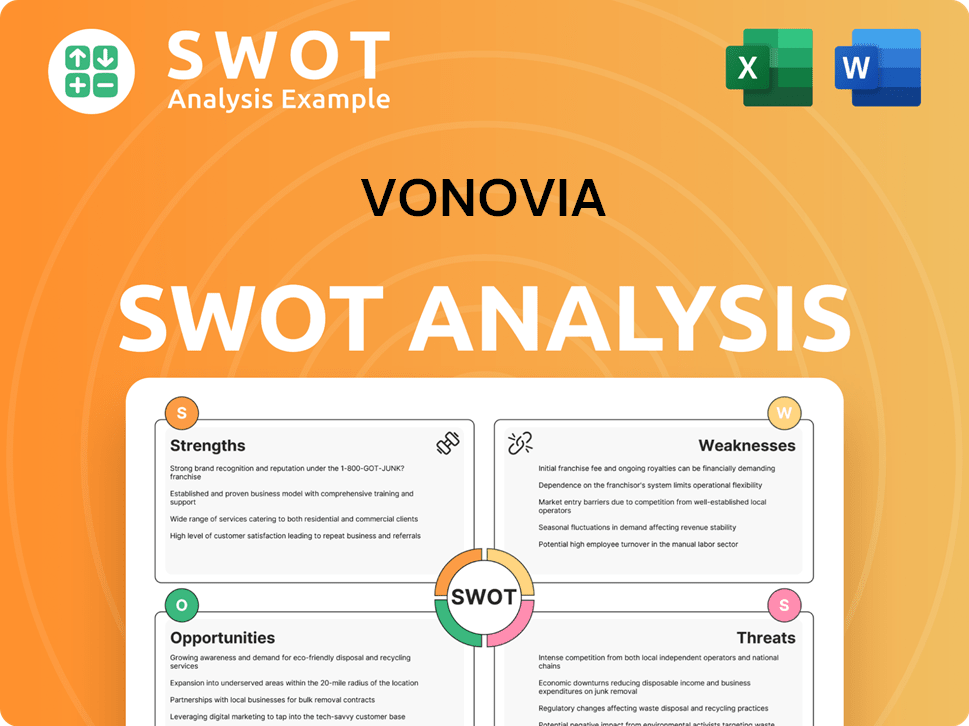
How Does Vonovia Invest in Innovation?
The company is significantly leveraging technology and innovation to drive its sustained growth, with a focus on digital transformation, automation, and cutting-edge technologies. Innovation is a core component of its strategy, aiming to develop future-fit solutions for innovative technologies and new services, particularly in response to megatrends like climate protection, digitalization, and demographic change.
The company's R&D investments and in-house development are evident in its emphasis on serial modernization, modular new builds, and modern heating infrastructure. Vonovia is pursuing 'serial refurbishment,' an industrialized system that standardizes and bundles all steps in the refurbishment process for energy efficiency. They are also forging ahead with investments in heat pump technology, including the new 'EnerCube' heating solution, which combines all necessary components in an external module.
The focus on innovation and technology is a key part of the Marketing Strategy of Vonovia, ensuring the company remains competitive in the evolving real estate investment landscape.
The company is heavily invested in digital transformation. This includes the use of digital tools for property management and tenant services, aiming to improve efficiency and customer satisfaction.
Automation plays a crucial role in streamlining operations. This includes automating processes in construction, maintenance, and customer service to reduce costs and improve response times.
The company is implementing serial refurbishment to standardize and accelerate the renovation process. This approach aims to improve energy efficiency and reduce renovation times.
Modular construction techniques are being utilized to build new properties more quickly and efficiently. This method reduces construction time and costs while maintaining quality.
Investments in heat pump technology, including the 'EnerCube' heating solution, are a key part of the company's sustainability efforts. These technologies aim to reduce carbon emissions and improve energy efficiency.
The company is integrating smart home technologies to enhance the living experience for tenants. This includes smart thermostats, security systems, and other connected devices.
Sustainability is deeply integrated into the technology strategy. The company has tightened its climate targets and has a binding Climate Roadmap to achieve a virtually climate-neutral building portfolio by 2045, with a net-zero standard beyond 2045.
- The company aims to reduce the carbon intensity of its German portfolio. In 2024, this was reduced by 1.6% to 31.2 kg CO2e/m².
- Spending on modernization and new builds will increase to around €1.2 billion in 2025, including major investments in photovoltaics.
- The company aims for 700 MWp of solar power generation and up to 14,000 heat pumps.
Vonovia PESTLE Analysis
- Covers All 6 PESTLE Categories
- No Research Needed – Save Hours of Work
- Built by Experts, Trusted by Consultants
- Instant Download, Ready to Use
- 100% Editable, Fully Customizable
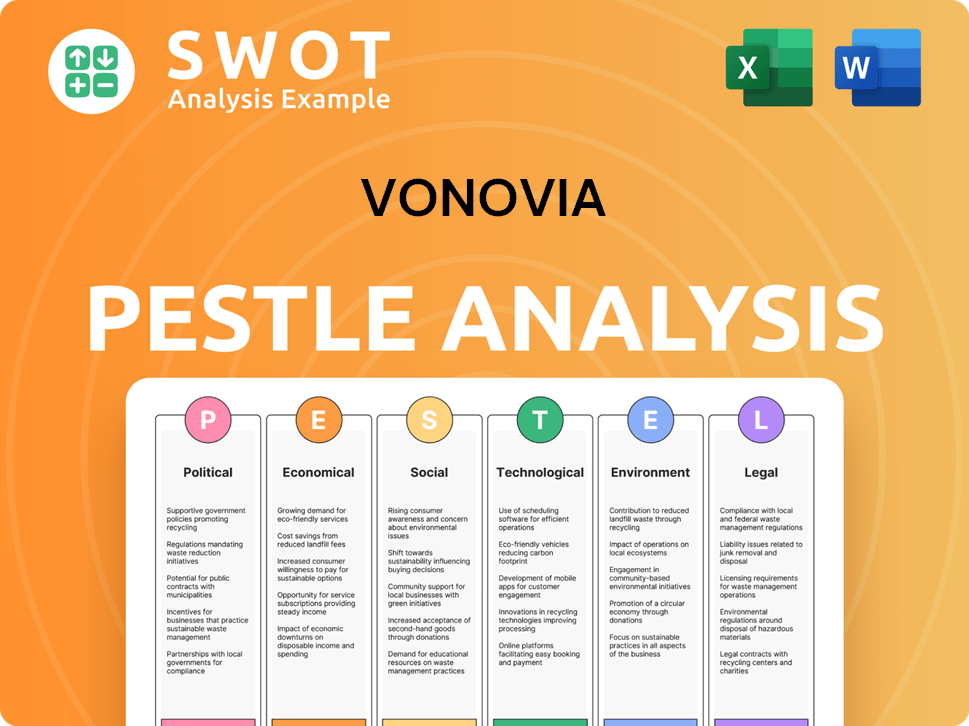
What Is Vonovia’s Growth Forecast?
In 2024, the company demonstrated a robust financial performance, successfully meeting its guidance targets and setting a strong base for future growth. The Adjusted EBITDA Total reached approximately €2.6 billion, with the rental business contributing significantly. This positive performance is a key indicator of the company's strong position in the real estate investment sector.
The company's focus on its core business, particularly its rental operations, has been a key driver of its financial success. The low vacancy rate of 2.0% and an organic rental growth of 4.1% highlight the stability and attractiveness of its portfolio. The narrowing of the net loss to €896.0 million from a previous year's loss of €6.29 billion, indicates effective restructuring and improved financial management.
Looking ahead, the company has an optimistic outlook for 2025 and beyond, with significant growth expected. The company's strategic initiatives and investments are designed to support its expansion plans in Germany and enhance its overall market position.
The company achieved an Adjusted EBITDA Total of approximately €2.6 billion in 2024. The rental business contributed 91% to this result. The net loss was significantly reduced to €896.0 million.
The company's portfolio maintained a low vacancy rate of 2.0%. Organic rental growth stood at 4.1%, demonstrating strong demand. These factors support the company's market share analysis.
For 2025, the company anticipates an Adjusted EBITDA between €2.7 billion and €2.8 billion. Adjusted EBT is projected to be between €1.75 billion and €1.85 billion. This reflects confidence in the company's long-term growth forecast.
By 2028, the company aims for an Adjusted EBITDA of approximately €3.2 billion to €3.5 billion. Value-add, Development, and Recurring Sales are expected to contribute between 20% and 25% to this total. This showcases the company's investment strategy.
Investments in upgrades, solar power expansion, and new construction are set to increase. Around €1.2 billion is planned for 2025, potentially reaching up to €2 billion by 2028. These investments are crucial for the company's sustainability initiatives.
Operating Free Cash Flow (OFCF) increased by 43.3% in Q1 2025, reaching €718.0 million compared to €501.0 million in Q1 2024. This positive trend indicates strong financial health and supports the company's expansion plans.
Property values stabilized in the second half of 2024 with a modest increase of 0.5%. The pro forma loan-to-value ratio was 45.8% at the end of 2024, nearly within the target range. This reflects the company's response to housing market challenges.
The management and supervisory boards intend to propose a dividend increase to €1.22 per share for 2024, up approximately 36% from €0.90 in 2023. This corresponds to a dividend yield of 4.2% as of June 1, 2025, demonstrating confidence in the company's financial stability and its commitment to shareholders. This is a key aspect of the company's dividend policy.
Restructuring efforts have improved liquidity and increased apartment sales. This strategic move supports the company's overall financial stability and its ability to navigate the German housing market. This is a key element of the company's competitive landscape.
All investment-grade ratings remain strong, which is crucial for maintaining financial flexibility and supporting future growth. This reinforces the company's ability to manage its financial obligations effectively. This is a key factor in assessing the impact of interest rates on the company.
The company's financial performance is supported by several key metrics that indicate its health and growth potential. These metrics are essential for a thorough Vonovia company analysis.
- Adjusted EBITDA: €2.6 billion in 2024, projected to be between €2.7 billion and €2.8 billion in 2025.
- Organic Rental Growth: 4.1% demonstrating strong demand and portfolio performance.
- Vacancy Rate: Low at 2.0%, indicating high occupancy and stable revenue streams.
- Dividend Yield: 4.2% as of June 1, 2025, reflecting shareholder value and financial stability.
- Loan-to-Value Ratio: 45.8% at the end of 2024, nearly within the target range.
Vonovia Business Model Canvas
- Complete 9-Block Business Model Canvas
- Effortlessly Communicate Your Business Strategy
- Investor-Ready BMC Format
- 100% Editable and Customizable
- Clear and Structured Layout
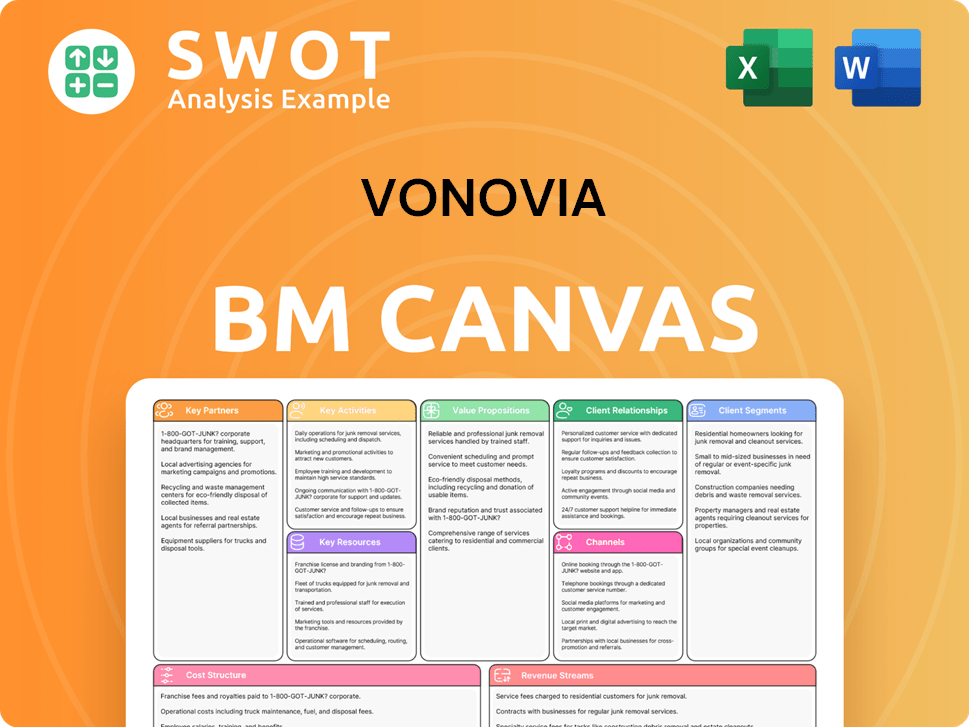
What Risks Could Slow Vonovia’s Growth?
The growth strategy of the company, a significant player in real estate investment, faces several risks and obstacles. These challenges span market dynamics, regulatory changes, and operational constraints. Understanding these potential pitfalls is crucial for evaluating the company's future prospects.
Market competition and evolving government policies are major external factors influencing the company. Internal challenges, such as managing a high debt load and adapting to technological advancements, also pose significant hurdles. A thorough company analysis requires a close examination of these risks.
The company's expansion plans in Germany are subject to various strategic and operational risks. The German housing market is currently reacting strongly to announced investment plans, creating uncertainty about housing prices and financing costs. Regulatory changes and technological disruptions add to the complexity.
Intense competition in the real estate market presents a persistent challenge. The competitive landscape includes both public and private sector entities. This can affect the company's ability to acquire properties and maintain occupancy rates.
Changes in regulations, particularly rental cap laws in Germany, could dampen growth. Potential tax reforms also pose a risk. These regulatory shifts can impact the company's profitability and investment returns.
Technological disruption, while also an area of innovation, presents a risk. Failure to adapt quickly enough to new advancements could hinder competitiveness. The company must invest in digital transformation to stay ahead. See Revenue Streams & Business Model of Vonovia to understand the company's strategy.
Supply chain vulnerabilities, especially regarding construction materials and their high prices, continue to impact construction projects and overall costs. These factors can lead to delays and increased expenses. The company must manage these risks effectively to keep projects on track.
The Development segment reported a €1.4 billion loss in 2024 due to rising material costs and interest rates. This highlights a key area of margin pressure. Improving profitability in this segment is crucial for overall financial health.
Internal resource constraints, such as the need for political frameworks to drive down construction costs, also pose an obstacle. The company's long-term new apartment goals depend on effective cost management. This requires strategic planning and collaboration.
The company's debt-heavy model, with approximately €16 billion in loans, makes it susceptible to rising borrowing costs. Despite efforts to deleverage and maintain investment-grade ratings, the high debt level presents a risk. The net debt/EBITDA ratio was at 14.5x in 2024.
The company's EPRA Loan-to-Value (LTV) ratio of 49% is higher than its target range. This indicates a need for prudent financial management. The company aims to reach its loan-to-value target of 40%-45% in a timely manner.
Vonovia Porter's Five Forces Analysis
- Covers All 5 Competitive Forces in Detail
- Structured for Consultants, Students, and Founders
- 100% Editable in Microsoft Word & Excel
- Instant Digital Download – Use Immediately
- Compatible with Mac & PC – Fully Unlocked
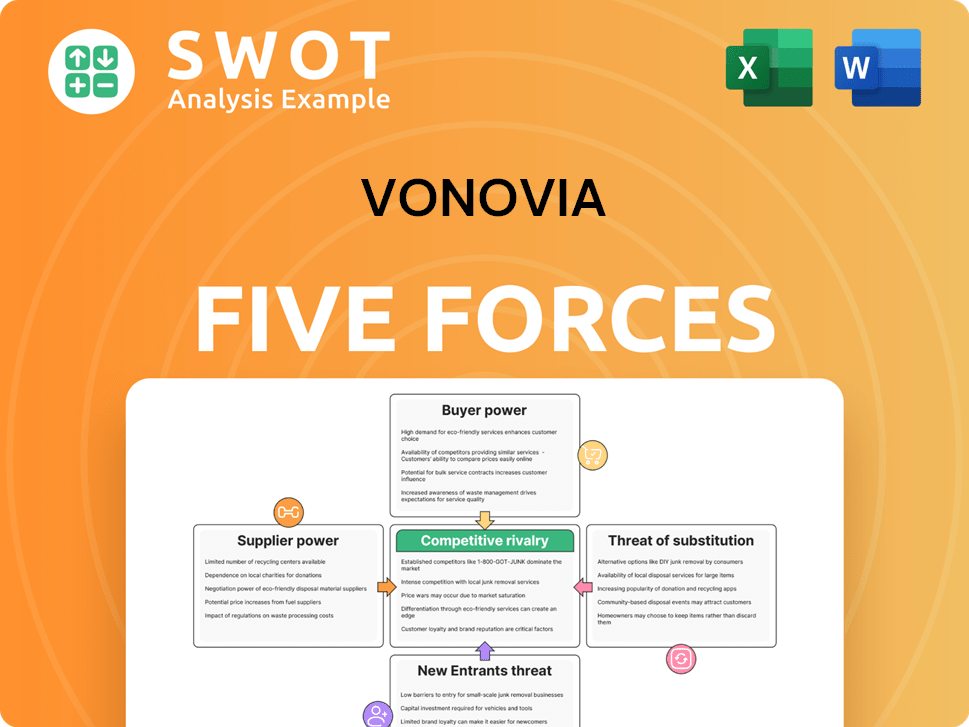
Related Blogs
- What are Mission Vision & Core Values of Vonovia Company?
- What is Competitive Landscape of Vonovia Company?
- How Does Vonovia Company Work?
- What is Sales and Marketing Strategy of Vonovia Company?
- What is Brief History of Vonovia Company?
- Who Owns Vonovia Company?
- What is Customer Demographics and Target Market of Vonovia Company?
Disclaimer
All information, articles, and product details provided on this website are for general informational and educational purposes only. We do not claim any ownership over, nor do we intend to infringe upon, any trademarks, copyrights, logos, brand names, or other intellectual property mentioned or depicted on this site. Such intellectual property remains the property of its respective owners, and any references here are made solely for identification or informational purposes, without implying any affiliation, endorsement, or partnership.
We make no representations or warranties, express or implied, regarding the accuracy, completeness, or suitability of any content or products presented. Nothing on this website should be construed as legal, tax, investment, financial, medical, or other professional advice. In addition, no part of this site—including articles or product references—constitutes a solicitation, recommendation, endorsement, advertisement, or offer to buy or sell any securities, franchises, or other financial instruments, particularly in jurisdictions where such activity would be unlawful.
All content is of a general nature and may not address the specific circumstances of any individual or entity. It is not a substitute for professional advice or services. Any actions you take based on the information provided here are strictly at your own risk. You accept full responsibility for any decisions or outcomes arising from your use of this website and agree to release us from any liability in connection with your use of, or reliance upon, the content or products found herein.